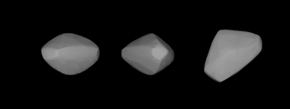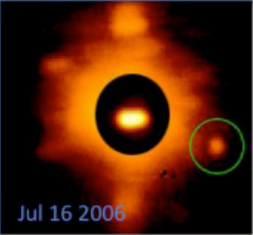
624 Hektor is the largest Jupiter trojan and the namesake of the Hektor family, with a highly elongated shape equivalent in volume to a sphere of approximately 225 to 250 kilometers diameter. It was discovered on 10 February 1907, by astronomer August Kopff at Heidelberg Observatory in southwest Germany, and named after the Trojan prince Hector, from Greek mythology. It has one small 12-kilometer sized satellite, Skamandrios, discovered in 2006.
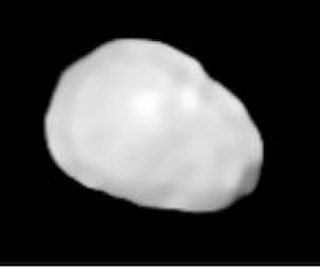
Eunomia is a very large asteroid in the middle asteroid belt. It is the largest of the stony (S-type) asteroids, with 3 Juno as a close second. It is quite a massive asteroid, in 6th to 8th place. It is the largest Eunomian asteroid, and is estimated to contain 1% of the mass of the asteroid belt.
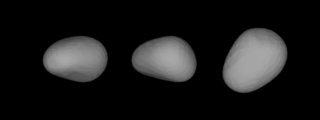
Nysa is a large and very bright main-belt asteroid, and the brightest member of the Nysian asteroid family. It is classified as a rare class E asteroid and is probably the largest of this type.
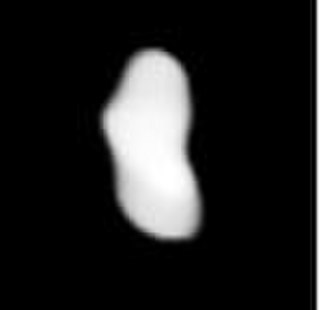
Ausonia is a stony Vestian asteroid from the inner region of the asteroid belt, approximately 100 kilometers in diameter. It was discovered by Italian astronomer Annibale de Gasparis on 10 February 1861, from the Astronomical Observatory of Capodimonte, in Naples, Italy. The initial choice of name for the asteroid was "Italia", after Italy, but this was modified to Ausonia, an ancient classical name for the Italian region.
3204 Lindgren, provisional designation 1978 RH, is a carbonaceous background asteroid from the outer regions of the asteroid belt, approximately 20 kilometers in diameter. It was discovered on 1 September 1978, by Soviet astronomer Nikolai Chernykh at the Crimean Astrophysical Observatory in Nauchnij, on the Crimean peninsula. The B-type asteroid has a rotation period of 5.6 hours. It was named after Swedish writer Astrid Lindgren.
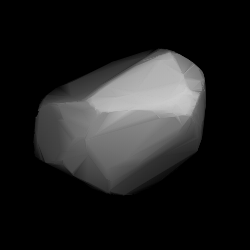
1088 Mitaka is a bright background asteroid from the inner regions of the asteroid belt. It was discovered on 17 November 1927, by Japanese astronomer Okuro Oikawa at the old Tokyo Astronomical Observatory in Japan. The stony S-type asteroid has a notably short rotation period of 3.0 hours and measures approximately 15 kilometers in diameter. It was named after the Japanese village of Mitaka.

9983 Rickfienberg is a carbonaceous asteroid from the middle region of the asteroid belt, approximately 10 kilometers in diameter. It was discovered on 19 February 1995, by American astronomer Dennis di Cicco at his private Sudbury Observatory, Massachusetts, United States. It was named after American astronomer and editor Richard Fienberg.

3752 Camillo is an inclined contact-binary asteroid, classified as near-Earth object of the Apollo group, approximately 2.3 kilometers in diameter. It was discovered on 15 August 1985, by astronomers Eleanor Helin and Maria Barucci using a 0.9-metre (35 in) telescope at the CERGA Observatory in Caussols, France. Lightcurve studies by Petr Pravec in 1998 suggest that the assumed S-type asteroid has an elongated shape and a longer-than average rotation period of 38 hours.
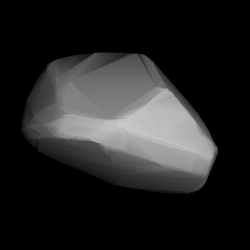
3544 Borodino (prov. designation: 1977 RD4) is a stony background asteroid from the inner regions of the asteroid belt, approximately 9 kilometers (5.6 miles) in diameter. It was discovered on 7 September 1977, by Soviet astronomer Nikolai Chernykh at the Crimean Astrophysical Observatory in Nauchnij, on the Crimean peninsula. The likely elongated S-type asteroid has a rotation period of 5.44 hours. It was named for the Russian village of Borodino where the Battle of Borodino took place.
83982 Crantor (provisional designation 2002 GO9) is a centaur in a 1:1 resonance with Uranus, approximately 60 kilometers (37 miles) in diameter. It was discovered on 12 April 2002, by astronomers of the Near-Earth Asteroid Tracking at the Palomar Observatory in California, United States. This minor planet was named for Crantor from Greek mythology.

1332 Marconia, provisional designation 1934 AA, is a dark asteroid and the parent body of the Marconia family located in the outer regions of the asteroid belt. It measures approximately 46 kilometers in diameter. The asteroid was discovered on 9 January 1934, by Italian astronomer Luigi Volta at the Observatory of Turin in Pino Torinese, northern Italy. It was named for Italian electrical engineer Guglielmo Marconi. The uncommon L-type asteroid has a rotation period of 19.2 hours.

2606 Odessa, provisional designation 1976 GX2, is a background asteroid from the central regions of the asteroid belt, approximately 16 kilometers (10 miles) in diameter. It was discovered on 1 April 1976, by Soviet–Russian astronomer Nikolai Chernykh at the Crimean Astrophysical Observatory in Nauchnij, on the Crimean peninsula. The presumably metallic X- or M-type asteroid has an elongated shape and a rotation period of 8.24 hours. It was named for the Ukrainian city of Odesa.

1389 Onnie, provisional designation 1935 SS1, is a stony Koronian asteroid from the outer region of the asteroid belt, approximately 13 kilometers in diameter. It was discovered on 28 September 1935, by Dutch astronomer Hendrik van Gent at Leiden Southern Station, annex to the Johannesburg Observatory in South Africa.
19383 Rolling Stones (provisional designation 1998 BZ32) is a bright Vestian asteroid from the inner regions of the asteroid belt, approximately 2.7 kilometers (1.7 miles) in diameter. The V-type asteroid was discovered on 29 January 1998, by astronomers with the OCA–DLR Asteroid Survey at Caussols in southern France and named for the rock band The Rolling Stones.

5208 Royer (prov. designation: 1989 CH1) is a stony Marian asteroid from the central regions of the asteroid belt, approximately 8 kilometers (5 miles) in diameter. It was discovered on 6 February 1989, by astronomer Eleanor Helin at the Palomar Observatory. The S-type asteroid has a rotation period of 3.87 hours and was named after American priest and amateur astronomer, Ronald Royer.

1493 Sigrid, provisional designation 1938 QB, is a dark Nysian asteroid from the inner regions of the asteroid belt, approximately 24 kilometers in diameter. It was discovered on 26 August 1938, by Belgian astronomer Eugène Delporte at the Royal Observatory of Belgium in Uccle. It was named after Sigrid Strömgren, wife of astronomer Bengt Strömgren.

32532 Thereus (; provisional designation 2001 PT13) is a centaur from the outer Solar System, approximately 80 kilometers (50 miles) in diameter. It was discovered on 9 August 2001, by astronomers of the Near-Earth Asteroid Tracking program at the Palomar Observatory in California, United States. This minor planet was named for the phrase thēreios bia 'beastly strength', used to describe centaurs in Greek mythology.
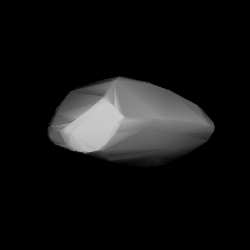
1946 Walraven is a stony asteroid from the inner regions of the asteroid belt, approximately 10 kilometers in diameter. It was discovered on 8 August 1931, by Dutch astronomer Hendrik van Gent at Leiden Southern Station, annex to the Johannesburg Observatory in South Africa, and named after astronomer Theodore Walraven.
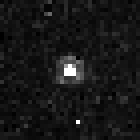
(82075) 2000 YW134 (provisional designation 2000 YW134) is a resonant trans-Neptunian object and binary system, located in the outermost region of the Solar System. It was discovered on 26 December 2000, by astronomers with the Spacewatch survey at Kitt Peak Observatory near Tucson, Arizona. The reddish object stays in a rare 3:8 resonance with Neptune. A smaller companion was discovered by the Hubble Space Telescope in October 2002. As of 2021, neither the primary body nor its satellite have been named.

Fine Guidance Sensor (FGS) for the Hubble Space Telescope is a system of three instruments used for pointing the telescope in space, and also for astrometry and its related sciences. To enable aiming the telescope at a specific spot in the sky, each FGS combines optics and electronics. There are three Hubble FGS, and they have been upgraded over the lifetime of the telescope by crewed Space Shuttle missions. The instruments can support pointing of 2 milli-arc seconds. The three FGS are part of the Hubble Space Telescope's Pointing Control System, aka PCS. The FGS function in combination with the Hubble main computer and gyroscopes, with the FGS providing data to the computer as sensors which enables the HST to track astronomical targets.
